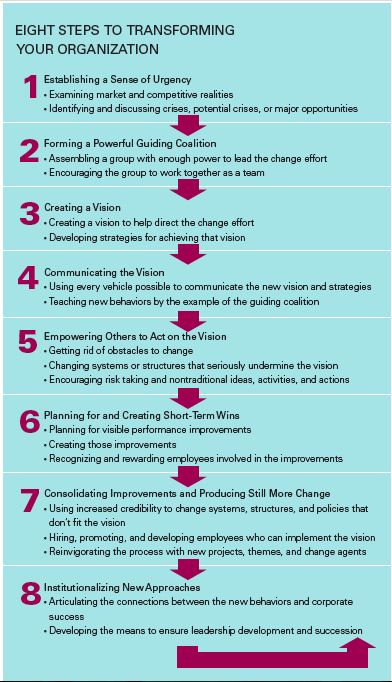Eight Steps to Transform Your Organization
Change is hard, really hard. Most days, I can barely muster the willpower to floss my teeth - even after deliberately placing the floss right next to my toothbrush. There are all sorts of things I should be doing everyday that I just don't, even though I know - intellectually - that my life will be better as a result.
Organizational change is even harder, orders of magnitude harder. It requires lots of people to adopt new behaviors, policies, procedures, etc. that are all significantly more difficult than flossing. Not to mention that all of this change has to be coordinated and executed at the same time across multiple sub-organizations while everyone trusts that moving away from the status quo won't negatively impact their ability to provide for their families.
Yet, there are times in our organizational lives where change must happen to continue thriving - or even surviving - in the current environment. This begs the question: "How do we maximize the probability of successfully effecting change in an organization?" I'm so glad you asked.
In Leading Change: Why Transformation Efforts Fail, John Kotter outlines 8 steps to transform an organization. These steps, along with common pitfalls, serve as a guiding framework to help enable change throughout an organization, regardless of size.

While these steps may seem straightforward on paper, they can be time consuming and difficult to achieve, regardless of the organizational environment you are in.
The most general lesson to be learned from the more successful cases is that the change process goes through a series of phases that, in total, usually require a considerable length of time. Skipping steps creates only the illusion of speed and never produces a satisfying result. A second very general lesson is that critical mistakes in any of the phases can have a devastating impact, slowing momentum and negating hard-won gains. Perhaps because we have relatively little experience in renewing organizations, even very capable people often make at least one big error. - Kotter HBR
Kotter also outlines eight errors that are commonly made during each phase of the process:
Error 1: Not Establishing a Great Enough Sense of Urgency - this first error accounts for "Over 50%" of change effort failures. Organizations can further improve their chances of success here by creating a sense of urgency out of a crisis or poor performance in the marketplace. However, even if the conditions are right for a change, it still takes the right leadership.
A paralyzed senior management often comes from having too many managers and not enough leaders. Management’s mandate is to minimize risk and to keep the current system operating. Change, by definition, requires creating a new system, which in turn always demands leadership. Phase one in a renewal process typically goes nowhere until enough real leaders are promoted or hired into senior-level jobs.
Error 2: Not Creating a Powerful Enough Guiding Coalition - Without enough people supporting the change at all levels of the organization, chances of success approach zero. Over time, a change effort should see an increase in support for the change - and not the opposition.
Efforts that don’t have a powerful enough guiding coalition can make apparent progress for a while. But, sooner or later, the opposition gathers itself together and stops the change.
Error 3: Lacking a Vision - There's already so much inertia within organizations that it's vital to communicate the change in a clear, understandable, and persuasive way.
A useful rule of thumb: If you can’t communicate the vision to someone in five minutes or less and get a reaction that signifies both understanding and interest, you are not yet done with this phase of the transformation process.
Error 4: Undercommunicating the Vision by a Factor of Ten - If you aren't absolutely sick of communicating the same message over and over again, you probably aren't communicating enough. A few emails and town hall meetings just won't cut it.
When communicating, think - message, medium, frequency, and behaviors.
Communication comes in both words and deeds, and the latter are often the most powerful form. Nothing undermines change more than behavior by important individuals that is inconsistent with their words.
Error 5: Not Removing Obstacles to the New Vision - Organizations are configured to persist the status quo. This isn't necessarily a bad thing - after all, this is what has made the company so successful in the first place. On that same note, when change is needed, parts of the organization will act as a blocker instead of an enabler. This needs to be addressed swiftly.
In the first half of a transformation, no organization has the momentum, power, or time to get rid of all obstacles. But the big ones must be confronted and removed. If the blocker is a person, it is important that he or she be treated fairly and in a way that is consistent with the new vision. Action is essential, both to empower others and to maintain the credibility of the change effort as a whole.
Error 6: Not Systematically Planning for, and Creating, Short-Term Wins - Success builds momentum, and momentum leads to greater success. Define shorter-term wins (and celebrate them!) during your change initiative to make sure you are creating a virtuous cycle.
Real transformation takes time, and a renewal effort risks losing momentum if there are no short-term goals to meet and celebrate. Most people won’t go on the long march unless they see compelling evidence in 12 to 24 months that the journey is producing expected results. Without short-term wins, too many people give up or actively join the ranks of those people who have been resisting change.
Error 7: Declaring Victory Too Soon - When you start celebrating your small wins, make sure you aren't declaring outright victory. Declaring victory too soon can immediately derail your initiative.
After a few years of hard work, managers may be tempted to declare victory with the first clear performance improvement. While celebrating a win is fine, declaring the war won can be catastrophic.
Error 8: Not Anchoring Changes in the Corporation’s Culture - once you have a pattern of success, ensure the trend continues. This is key around continued communication and succession planning.
In the final analysis, change sticks when it becomes “the way we do things around here,” when it seeps into the bloodstream of the corporate body. Until new behaviors are rooted in social norms and shared values, they are subject to degradation as soon as the pressure for change is removed.
Facilitating change within an organization is much more difficult than we realize. Taking a pragmatic - and patient - approach through the steps Kotter outlines above will increase our chances of successfully realizing the change we want and need within our organizations.
Subscribe for Free
Want to stay ahead of the curve? Subscribe now to receive the latest updates, actionable insights, and thought-provoking ideas around business, technology, and leadership straight to your inbox.



